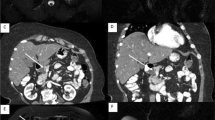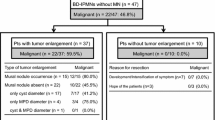Abstract
It is clear that the prevalence of malignancy is high in the main-duct type of intraductal papillary-mucinous neoplasm (IPMN). Branch-duct IPMNs include several histologic conditions such as carcinoma, adenoma, and hyperplasia. Intraductal papillary adenocarcinoma and papillary adenoma are characterized by papillary protrusions and thick septum-like structures in dilated ducts as delineated by ultrasonography. A solid mass showing a mixedecho pattern in the pancreatic parenchyma is a characteristic finding of invasive types of IPMN. The international guidelines for the management of branch-duct IPMNs suggest that the appearance of symptoms attributable to the cyst, the presence of intramural nodules, a cyst size greater than 30 mm, and dilation of the main pancreatic duct (>6 mm) are indications for resection. Based on the relationship between the height of a papillary protrusion and the diameter of a cystic dilated branch as well as on histological findings, branch-duct IPMNs with papillary protrusions more than 10 mm in height as shown by imaging should be resected, and it is not adequate to differentiate carcinoma from other lesions based on the diameter of cystic branches alone. A follow-up study on branch-duct IPMNs revealed that most papillary protrusions showed a slow increase in size or development of lateral spread, and that there was no development of cancer with stromal invasion during an average follow-up of 46 months. Therefore, the presence of intramural nodules alone should not be an indication for surgery. Also, patients without papillary protrusions or thick septum-like structures are not immediate candidates for surgery. Invasive adenocarcinoma can develop at a pancreatic site different from the area of interest showing cystic changes, with such invasion possibly being multicentric. Therefore, in patients with branch-duct IPMNs, attention should be paid to the entire pancreas when performing follow-up examinations.
Similar content being viewed by others
References
Ohashi K, Murakami Y, Maruyama M, et al. Four cases of mucous-secreting pancreatic cancer. Prog Dig Endosc 1982;20:348–351 (in Japanese).
Longnecker DS, Hruben RH, Adler G, et al. Intraductal papillary-mucinous neoplasms of the pancreas. Lyon: World Health Organization Classification of Tumors, International Agency for Research on Cancer; 2000. p. 237–240.
Tanaka M, Chari S, Adsay V, et al. International consensus guidelines for management of intraductal papillary-mucinous neoplasms and mucinous cystic neoplasms of the pancreas. Pancreatology 2006;6:17–32.
Kobayashi G, Fujita N, Noda Y, et al. Mode of progression of intraductal papillary-mucinous tumor of the pancreas: analysis of patients with follow-up by EUS. J Gastroenterol 2005;40:744–751.
Kobayashi G, Fujita N, Noda Y, et al. Three morphological types of mucinous cystic tumor of the pancreas: correlation between morphological features and histological findings. In: Wakui A, Yamauchi H, Ouchi K, editors. Carcinoma of the pancreas and biliary tract. Sendai: Tohoku University Press; 1999. p. 203–212.
Kimura W, Sasahira N, Yoshikawa T, et al. Duct-ectatic type of mucin-producing tumor of the pancreas: new concept of pancreas neoplasia. Hepatogastroenterology 1996;43:692–709.
Loftus E, Olivares-Pakzad B, Batts K, et al. Intraductal papillary-mucinous tumors of the pancreas: clinicopathological features, outcome, nomenclature. Gastroenterology 1996;110:1909–1918.
Kobayashi G, Fujita N, Lee S, et al. Correlation between ultrasonographic findings and pathological diagnosis of the mucin-producing tumor of the pancreas. Nippon Shokakibyo Gakkai Zasshi (Jpn J Gastroenterol) 1990;87:235–242 (in Japanese).
Obara T, Maguchi H, Saitoh Y, et al. Mucin-producing tumor of the pancreas: a unique clinical entity. Am J Gastroenterol 1991;86:1619–1625.
Obara T, Maguchi H, Saitoh Y, et al. Mucin-producing tumor of the pancreas: natural history and serial pancreatogram changes. Am J Gastroenterol 1993;88:564–568.
Cellier C, Cuillerier E, Palazzo L, et al. Intraductal papillary and mucinous tumors of the pancreas: accuracy of preoperative computed tomography, endoscopic retrograde pancreatography and endoscopic ultrasonography, and long-term outcome in a large surgical series. Gastrointest Endosc 1998;47:42–49.
Yamao K, Nakazawa S, Naitoh Y, et al. Clinicopathological study of the mucous-producing pancreatic tumors. Nippon Shokakibyo Gakkai Zasshi (Jpn J Gastroenterol) 1986;161:697–700 (in Japanese).
Morohoshi T, Kanda M, Asanuma K, et al. Intraductal papillary neoplasms of the pancreas. A clinicopathologic study of six patients. Cancer 1989;64:1329–1335.
Fujita N, Lee S, Kobayashi G, et al. Pancreatoscopy for mucous-producing pancreatic tumor. Dig Endosc 1990;2:110–115.
Compagno J, Oertel JE. Mucinous cystic neoplasms of the pancreas with overt and latent malignancy (cystadenocarcinoma and cystadenoma). Am Soc Clin Pathol 1978;69:573–580.
Kloppel C. Pancreatic nonendocrine tumors. In: Kloppel C, Heitz PH, editors. Pancreatic pathology. Edinburgh: Churchill Livingstone; 1984. p. 79–113.
Yanagisawa A, Kato Y, Ohtake K, et al. Ki-ras point mutation in duct ectatic-type mucinous cystic neoplasms of the pancreas. Jpn J Cancer Res 1991;82:1057–1060.
Kobari M, Egawa S, Shibuya K, et al. Intraductal papillary-mucinous tumors of the pancreas comprise two clinical subtypes. Arch Surg 1999;134:1131–1136.
Yamaguchi K, Ogawa Y, Chijiiwa K, et al. Mucin-hypersecreting tumors of the pancreas: assessing the grade of malignancy preoperatively. Am J Surg 1996;171:427–431.
Kitagawa Y, Unger TA, Taylor S, et al. Mucus is a predictor of better prognosis and survival in patients with intraductal papillary-mucinous tumor of the pancreas. J Gastrointest Surg 2003;7:12–19.
Sohn TA, Yeo CJ, Cameron JL, et al. Intraductal papillary-mucinous neoplasms of the pancreas: an updated experience. Ann Surg 2004;239:788–799.
Salvia R, Fernández-del Castillo C, Bassi C, et al. Main duct intraductal papillary-mucinous neoplasms of the pancreas: clinical predictors of malignancy and long-term survival following resection. Ann Surg 2004;239:678–687.
Chari S, Yadav D, Smyrk TC, et al. Study of recurrence after surgical resection of intraductal papillary-mucinous tumors of the pancreas. Gastroenterology 2002;123:1500–1507.
Kobayashi G, Fujita N, Noda Y, et al. Histologic features and prognosis of mucinous cystic tumor of the pancreas. In: Wakui A, Yamauchi H, Ouchi K, editors. Carcinoma of the pancreas and biliary tract. Sendai: Tohoku University Press; 1999. p. 213–218.
Maguchi H. Clinicopathological and diagnostic study of mucin-producing pancreatic tumors. Jpn J Gastroenterol 1994;91:1003–1015 (in Japanese with English abstract).
Sugiyama M, Atomi Y. Intraductal papillary-mucinous tumors of the pancreas: imaging studies and treatment strategies. Ann Surg 1998;228:685–691.
Koito K, Namieno T, Ichimura T, et al. Mucin-producing pancreatic tumors: comparison of MR cholangiopancreatography with endoscopic retrograde cholangiopancreatography. Radiology 1998;208:231–237.
Kubo H, Chijiiwa Y, Akahoshi K, et al. Intraductal papillary-mucinous tumors of the pancreas: differential diagnosis between benign and malignant tumors by endoscopic ultrasonography. Am J Gastroenterol 2001;96:1429–1434.
Koito K, Namieno T, Nagakawa T, et al. Solitary cystic tumor of the pancreas: EUS-pathologic correlation. Gastrointest Endosc 1997;45:268–276.
Inui K, Nakazawa S, Yoshino J, et al. Mucin-producing tumor of the pancreas: intraluminal ultrasonography. Hepatogastroenterology 1998;45:1996–2000.
Sugiyama M, Atomi Y, Saito M. Intraductal papillary tumors of the pancreas: evaluation with endoscopic ultrasonography. Gastrointest Endosc 1998;48:164–171.
Yamao K, Ohashi K, Nakamura T, et al. Evaluation of various imaging methods in the differential diagnosis of intraductal papillary-mucinous tumor (IPMT) of the pancreas. Hepatogastroenterology 2001;48:962–966.
Kobayashi G, Fujita N, Noda Y, et al. Study of cases of mucin-producing tumor of the pancreas showing penetration of other organs. Nippon Shokakibyo Gakkai Zasshi (Jpn J Gastroenterol) 1993;90:3081–3089 (in Japanese).
Yamaguchi K, Chijiwa K, Shimizu S, et al. Comparison of endoscopic retrograde and magnetic resonance cholangiopancreatography in the surgical diagnosis of pancreatic diseases. Am J Surg 1998;175:203–208.
Procacci C, Carbognin G, Accodini S, et al. CT features of malignant mucinous cystic tumor of the pancreas. Eur Radiol 2001;11:1626–1630.
Terris B, Ponsot P, Paye F, et al. Intraductal papillary-mucinous tumors of the pancreas confined to secondary ducts show less aggressive pathologic features as compared with those involving the main pancreatic duct. Am J Surg Pathol 2000;24:1372–1377.
Doi R, Fujimoto K, Wada M, et al. Surgical management of intraductal papillary-mucinous tumor of the pancreas. Surgery 2002;132:80–85.
Matsumoto T, Aramaki M, Yada K, et al. Optimal management of the branch duct-type intraductal papillary-mucinous neoplasms of the pancreas. J Clin Gastroenterol 2003;36:261–265.
Sugiyama M, Izumisato Y, Abe N, et al. Predictive factors for malignancy in intraductal papillary-mucinous tumors of the pancreas. Br J Surg 2003;90:1244–1249.
Irie H, Yoshimitsu K, Aibe H, et al. Natural history of pancreatic intraductal papillary-mucinous tumor of branch duct type: follow-up study by magnetic resonance cholangiopancreatography. J Comput Assist Tomogr 2004;28:117–122.
Wakabayashi T, Kawaura Y, Morimoto H, et al. Clinical management of intraductal papillary-mucinous tumors of the pancreas based on imaging findings. Pancreas 2001;22:370–377.
Yamaguchi K, Sugitani A, Chijiiwa K, et al. Intraductal papillary-mucinous tumor of the pancreas: assessing the grade of malignancy from natural history. Am Surg 2001;67:400–406.
Kobayashi G, Fujita N, Noda Y, et al. Patients with intraductal mucinous neoplasms of the pancreas: resection or follow-up? Endosc Dig 2007;19:1101–1110 (in Japanease with English abstract).
Collins VP, Loeffler RK, Tivey H. Observations on growth rates of human tumors. Am J Roentgenol 1956;76:988–1000.
Taki T, Goto H, Naitoh Y, et al. Diagnosis of mucin-producing tumor of the pancreas with an intraductal ultrasonographic system. J Ultrasound Med 1997;16:1–6.
Inui K, Nakazawa S, Yoshino J, et al. Mucin-producing tumor of the pancreas: intraductal ultrasonography. Hepatogastroenterology 1998;45:1996–2000.
Nakamura Y, Nakazawa S, Yamao K, et al. Evaluation of intraductal ultrasonography of the pancreas for intraductal papillary tumor. Gastroenterol Endosc 1997;39:42–51 (in Japanese with English abstract).
Ito K, Fujita N, Noda Y, et al. Clinical significance of intraductal ultrasonography for diagnosis of intraductal papillary-mucinous neoplasm of the pancreas. Dig Endosc 2006;18:S73–S77.
Fujita N, Yokohata K, Maguchi H, et al. Newly developed ultrasonic probe with ropeway system for transpapillary intraductal ultrasonography of the bilio-pancreatic ductal system. Dig Endosc 2000;12:250–254.
Uehara H, Nakaizumi A, Tatsuta M, et al. Diagnosis of carcinoma in situ of the pancreas by peroral pancreatoscopy and pancreatoscopic cytology. Cancer 1997;79:454–461.
Yamao K, Ohashi K, Nakamura T, et al. Efficacy of peroral pancreatoscopy in the diagnosis of pancreatic diseases. Gastrointest Endosc 2003;57:205–209.
Igarashi Y, Miura T, Okano N, et al. Endoscopic diagnosis of intraductal papillary-mucinous neoplasm using peroral pancreatoscopy with narrow band imaging. Dig Endosc 2007;19:S105–S108
Hara T, Yamaguchi T, Ishihara T, et al. Diagnosis and patient management of intraductal papillary-mucinous tumor of the pancreas by using peroral pancreatoscopy and intraductal ultrasonography. Gastroenterology 2002;122:34–43.
Izawa T, Obara T, Tanno S, et al. Clonality and field cancerization in intraductal papillary-mucinous tumors of the pancreas. Cancer 2001;92:1807–1807.
Yamaguchi K, Ohuchida J, Ohtsuka T, et al. Intraductal papillary-mucinous tumor of the pancreas concomitant with ductal carcinoma of the pancreas. Pancreatology 2002;2:484–490.
Author information
Authors and Affiliations
Corresponding author
About this article
Cite this article
Kobayashi, G., Fujita, N., Noda, Y. et al. Ultrasonographic findings and natural history of intraductal papillary-mucinous neoplasms of the pancreas. J Med Ultrasonics 35, 85–96 (2008). https://doi.org/10.1007/s10396-008-0188-9
Received:
Accepted:
Published:
Issue Date:
DOI: https://doi.org/10.1007/s10396-008-0188-9




